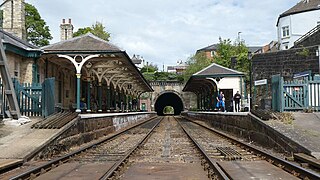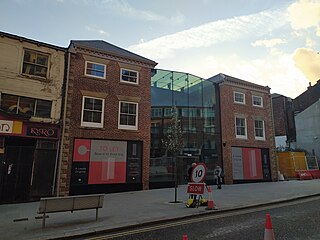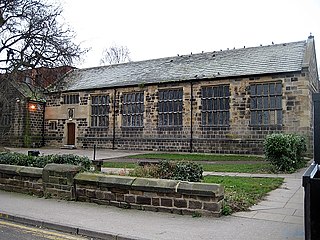
Northgate is a street in the city centre of Wakefield, in West Yorkshire, in England.

Northgate is a street in the city centre of Wakefield, in West Yorkshire, in England.
The street dates from the Mediaeval period, when it was one of three major roads in the town, heading towards Leeds. It was at the centre of one of the town's three quarters. A gatehouse was constructed across the street, near the location of the Chantry of St John the Baptist, later the location of the grammar school. The part of the street near the town became built up with burgage plots, although there were fewer than on Westgate and Kirkgate. Numerous buildings on the street were demolished in the 1960s. [1] [2] The Transforming Cities Fund describes the road as "a key route between the city centre, St Johns and the M1". [3]

The street starts at a junction with Westgate and Kirkgate. It runs north, past the west end of Wakefield Cathedral, and junctions with Bread Street and Cross Square. It then opens out into the Bull Ring square, off which Marygate, Westmorland Street, Union Street and Radcliffe Place run. It then turns north-west, past junctions with Talbot and Falcon Yard, Cross Street, Providence Street, Gill's Yard, Rishworth Street, and Upper York Street. At a roundabout, it meets Marsh Way, and becomes the A61 road. It has junctions with Cardigan Terrace, Arundel Street, Wentworth Terrace, Howard Street, Albion Street, and North Road Terrace, before terminating at a crossroads with St John's North and Westfield Road. Beyond this, its continuation is Leeds Road.
Listed buildings on the street include 2–10 Northgate, dating from around 1800; [4] the late-15th century timber-framed 53 and 55 Northgate; [5] the 16th-century 57 Northgate, part of which was formerly the warehouse of Wright and Elwick furniture makers; [6] the large houses at 71 an 95 Northgate, dating from about 1800; [7] [8] the early-19th century terrace of 87–93 Northgate [9] and similarly dated 97 and 99 Northgate; [10] the buildings of the Queen Elizabeth Grammar School; [11] and an early-19th century house at 158 Northgate. [12] Another notable building is the Talbot & Falcon pub, which has lain on the street since 1700. [13]

Elland is a market town in Calderdale, in the county of West Yorkshire, England. It is situated south of Halifax, by the River Calder and the Calder and Hebble Navigation. Elland was recorded as Elant in the Domesday Book of 1086. It had a population in 2001 of 14,554, with the ward being measured at 11,676 in the 2011 Census.

Wakefield is a cathedral city in West Yorkshire, England located on the River Calder. The city had a population of 109,766 in the 2021 census, up from 99,251 in the 2011 census. The city is the administrative centre of the wider Metropolitan Borough of Wakefield, which had a 2022 population of 357,729, the 26th most populous district in England. It is part of the West Yorkshire Built-up Area and the Yorkshire and The Humber region.

Tadcaster is a market town and civil parish in North Yorkshire, England, 15 miles (24 km) north-east of Leeds and 10 miles (16 km) south-west of York.

Wakefield Kirkgate railway station is a railway station in Wakefield, West Yorkshire, England. Unlike the nearby Wakefield Westgate railway station, Kirkgate is unstaffed. The station is managed by Northern but also served by Grand Central and TransPennine Express. It is on the Hallam, Calder Valley, Pontefract and Huddersfield lines. It has a limited number of services to London King's Cross.

Wakefield Westgate railway station is a mainline railway station in Wakefield, West Yorkshire, England. It is 10 miles (16 km) south of Leeds to the west of the city centre, on the Wakefield Line and Leeds branch of the East Coast Main Line.

Huddersfield railway station serves the town of Huddersfield in West Yorkshire, England.

Knaresborough railway station is a Grade II listed station serving the town of Knaresborough in North Yorkshire, England. It is located on the Harrogate Line 16.75 miles (27 km) west of York and is operated by Northern Trains, who provide all passenger train services.

The 1st White Cloth Hall is a Grade II* listed building on Kirkgate, in the city centre of Leeds in West Yorkshire, England.

Wakefield Cathedral, or the Cathedral Church of All Saints in Wakefield, West Yorkshire, England, is a co-equal Anglican cathedral with Bradford and Ripon Cathedrals, in the Diocese of Leeds and a seat of the Bishop of Leeds. Originally the parish church, it has Anglo Saxon origins and, after enlargement and rebuilding, has the tallest spire in Yorkshire. Its 247-foot (75 m) spire is the tallest structure in the City of Wakefield. The cathedral was designated a Grade I listed building on 14 July 1953.
Louisa Fennell (1847–1930) was an English watercolour painter. She was best known as a painter of landscapes and townscapes of the towns and cities of the West Riding of Yorkshire, particularly the County town of Wakefield, its surrounding area, and the city of York.

The Chantry Chapel of St Mary the Virgin is a chantry chapel in Wakefield, West Yorkshire, England, and is designated a Grade I Listed building by English Heritage. It is located south of the city centre on the medieval Chantry Bridge over the River Calder. It is the only survivor of four chantries in Wakefield and the oldest and most ornate of the surviving bridge chapels in England. Others are at St Ives (Cambridgeshire), Rotherham, Derby and Bradford-on-Avon. The chapel has had three west fronts, the original medieval façade having been removed to Kettlethorpe Hall in 1832. The medieval bridge is a scheduled ancient monument.

Sleaford – historically called New Sleaford – is a market town in the North Kesteven district of Lincolnshire, England. There are 181 listed buildings in the civil parish of Sleaford, which, along with the town, incorporates the village of Quarrington, the hamlet of Holdingham and the former ancient parish of Old Sleaford. One of the buildings is classified by Historic England as being in Grade I, six in Grade II* and 174 in Grade II.
Newsome is a ward of Huddersfield in the metropolitan borough of Kirklees, West Yorkshire, England. It contains over 430 listed buildings that are recorded in the National Heritage List for England. Of these, one is listed at Grade I, the highest of the three grades, 17 are at Grade II*, the middle grade, and the others are at Grade II, the lowest grade. The ward is large, and contains the centre of the town of Huddersfield, and areas to the west and south. This list contains the listed buildings in the centre of the town, namely those within the ring road. The listed buildings in the outer areas, those within the ward but outside the ring road, are at Listed buildings in Huddersfield
Wakefield is a city in the metropolitan district of the City of Wakefield, West Yorkshire, England. In the city and surrounding area are 195 listed buildings that are recorded in the National Heritage List for England. Of these, seven are listed at Grade I, the highest of the three grades, 18 are at Grade II*, the middle grade, and the others are at Grade II, the lowest grade. Historically a market town, it was the chief wool market in Yorkshire in the 18th century, and in the 19th century the cattle market was the largest in the north of England. The prosperity from this is reflected in the size of the parish church, and in the large number of fine Georgian houses, many of which are listed.

Kirkgate is a street in the city centre of Leeds, in England.

Vicar Lane is a street in the city centre of Leeds, a city in England.

Westgate is a street in the city centre of Wakefield, a city in West Yorkshire, in England.

Kirkgate is a street in the city centre of Wakefield, in West Yorkshire, in England.

The Elizabethan Gallery is a Grade II* listed historic building in the city centre of Wakefield, in West Yorkshire, England.

Wakefield Old Town Hall, also known as No. 5 Crown Court, is a historic building in the city centre of Wakefield, in West Yorkshire, in England. After operating as a town hall from 1861 to 1880, it served as an organ factory and then as commercial offices, before being adapted for residential use.